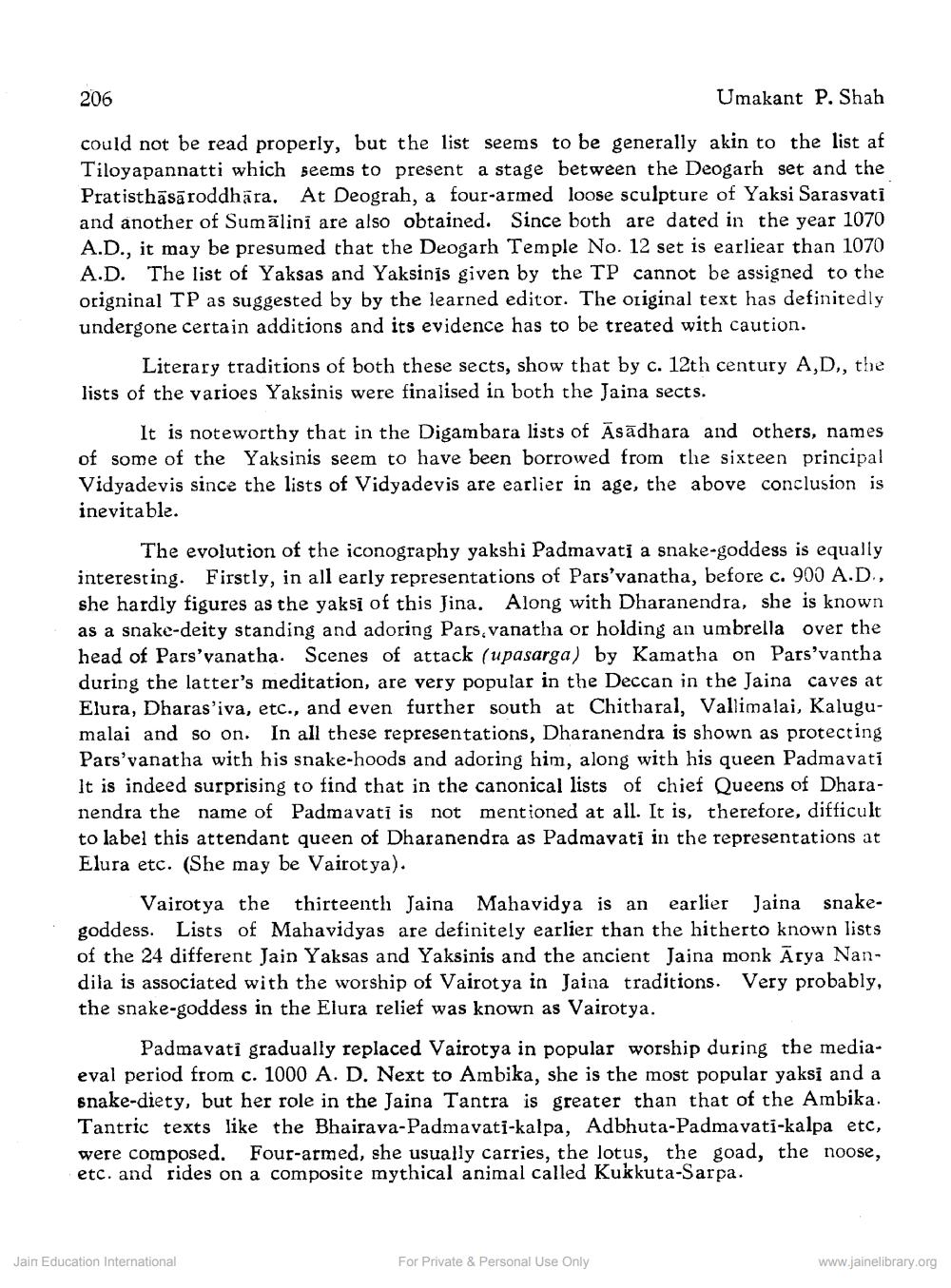________________
206
Umakant P. Shah
could not be read properly, but the list seems to be generally akin to the list af Tiloyapannatti which seems to present a stage between the Deogarh set and the Pratisthāsā roddhāra. At Deograh, a four-armed loose sculpture of Yaksi Sarasvati and another of Sumālini are also obtained. Since both are dated in the year 1070 A.D., it may be presumed that the Deogarh Temple No. 12 set is earliear than 1070 A.D. The list of Yaksas and Yaksinis given by the TP cannot be assigned to the origninal TP as suggested by by the learned editor. The original text has definitedly undergone certain additions and its evidence has to be treated with caution.
Literary traditions of both these sects, show that by c. 12th century A,D,, the lists of the varioes Yaksinis were finalised in both the Jaina sects.
It is noteworthy that in the Digambara lists of Āsādhara and others, names of some of the Yaksinis seem to have been borrowed from the sixteen principal Vidyadevis since the lists of Vidyadevis are earlier in age, the above conclusion is inevitable.
The evolution of the iconography yakshi Padmavati a snake-goddess is equally interesting. Firstly, in all early representations of Pars'vanatha, before c. 900 A.D., she hardly figures as the yaksi of this Jina. Along with Dharanendra, she is known as a snake-deity standing and adoring Pars, vanatha or holding an umbrella over the head of Pars'vanatha. Scenes of attack (upasarga) by Kamatha on Pars'vantha during the latter's meditation, are very popular in the Deccan in the Jaina caves at Elura, Dharas'iva, etc., and even further south at Chitharal, Vallimalai, Kalugumalai and so on. In all these representations, Dharanendra is shown as protecting Pars'vanatha with his snake-hoods and adoring him, along with his queen Padmavati It is indeed surprising to find that in the canonical lists of chief Queens of Dharanendra the name of Padmavati is not mentioned at all. It is, therefore, difficult to label this attendant queen of Dharanendra as Padmavati in the representations at Elura etc. (She may be Vairot ya).
Vairotya the thirteenth Jaina Mahavidya is an earlier Jaina snakegoddess. Lists of Mahavidyas are definitely earlier than the hitherto known lists of the 24 different Jain Yaksas and Yaksinis and the ancient Jaina monk Arya Nandila is associated with the worship of Vairotya in Jaina traditions. Very probably, the snake-goddess in the Elura relief was known as Vairotya.
Padmavati gradually replaced Vairotya in popular worship during the mediaeval period from c. 1000 A. D. Next to Ambika, she is the most popular yaksi and a snake-diety, but her role in the Jaina Tantra is greater than that of the Ambika. Tantric texts like the Bhairava-Padmavati-kalpa, Adbhuta-Padmavati-kalpa etc, were composed. Four-armed, she usually carries, the lotus, the goad, the noose, etc. and rides on a composite mythical animal called Kukkuta-Sarpa.
Jain Education International
For Private & Personal Use Only
www.jainelibrary.org




